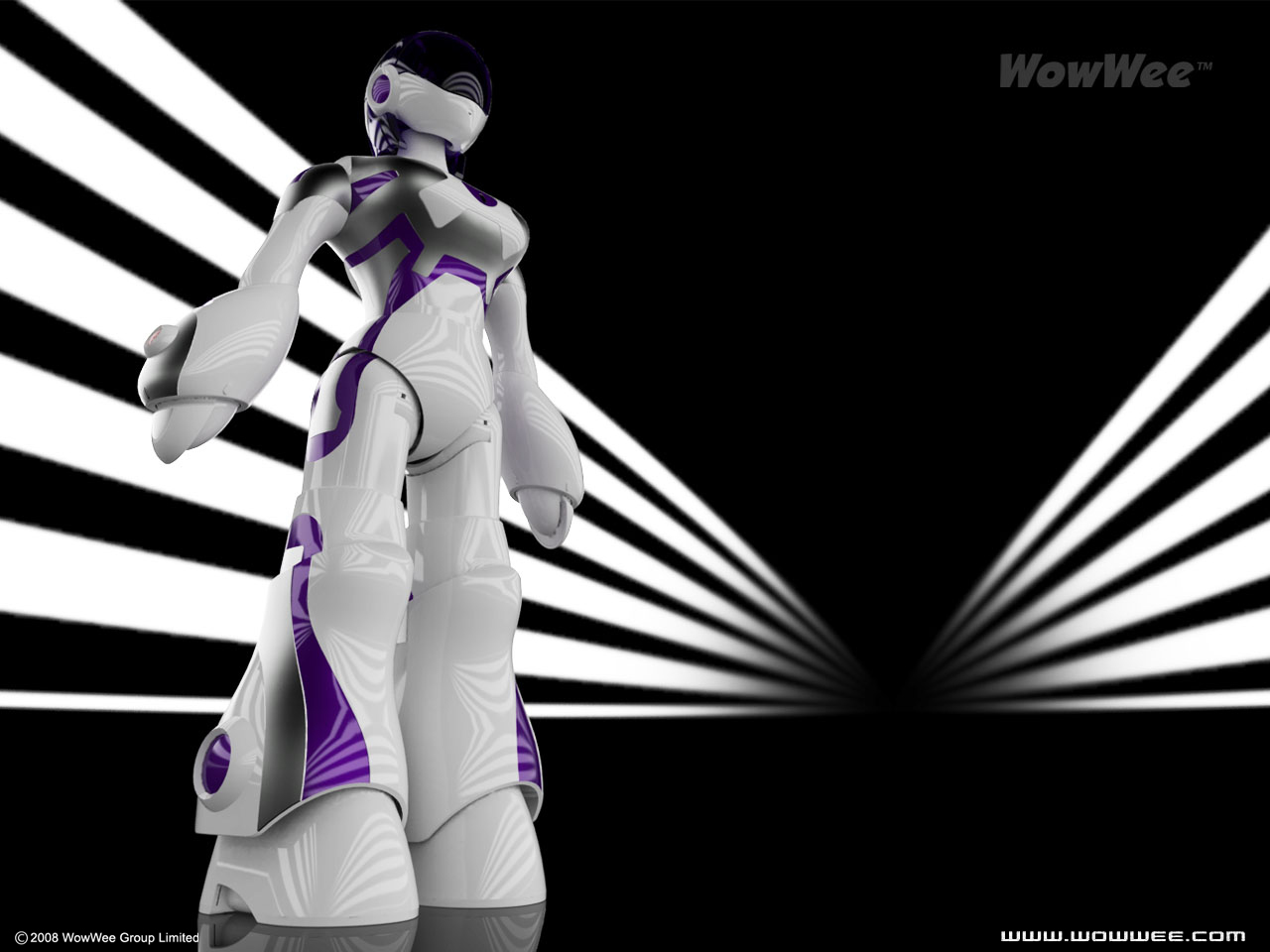Beth sent in a link to WowWee, a company that makes robot toys, including Robosapien:
The description of Robosapien:
Robosapien™ is a sophisticated fusion of technology and personality. Loaded with attitude and intelligence, Robosapien is the first robot based on the science of applied biomorphic robotics. With a full range of dynamic motion, interactive sensors and a unique personality, Robosapien is more than a mechanical companion — he’s a multi-functional, thinking, feeling robot with attitude!
There is also a female version, called Femisapien:
From the website:
Intelligent and interactive, RS Femisapien™ speaks her own language called “emotish” which consists of gentle sounds and gestures. There is no remote required; interact with her directly and she responds to your hand gestures, touch, and sound.
So the default robot is male, with the female being not a female Robosapien but rather an entirely different product. And the photos and descriptions of Robosapien emphasize aggression, movement, personality, and “attitude,” while Femisapien speaks “emotish” (seriously?), which is “gentle”–a characteristic that seems to be missing from Robosapien, who is dynamic and, um, maybe shoots lasers from his hands.
It’s a nice example of gendered assumptions being built into product design and marketing. There’s no particular reason that the male and female versions of a robot have to look so very different, but even if they did, the decision to associate one with words and characteristics that evoke emotion and gentleness and the other with aggression and movement isn’t accidental; it’s a result of how we think about males and females.
For another excellent example of the men are people and women are women thing, see this post on the Body Worlds exhibit.
NEW! Kyle M. sent us a link to his post on the advertising for the sci-fi show Surrogates. He makes some great observations. I noticed, too, that the way in which the robotic components of men and women were designed differed slightly in gendered ways. The “spines” of the men are significantly more robust than the thin, spindly spines given to the female characters. Notice, also, that the way in which the models are posed emphasizes women’s thinness (in all of these ads, she is positioned sideways, minimizing her size) and men’s broadness (positioned so that the width of his body is emphasized).








Comments 19
Dubi — January 11, 2009
What does "male" and "female" even MEAN for robots? Do they copulate? The only "biologically" female thing about the female version is that, inexplicably, she has breasts (and very large ones, at that). Other from that, she's more "feminine" than "female", that is, as you say, gendered. Is there an assumption that girls simply can't relate to a robot without oversized boobs? I wonder...
thoughtcounts Z — January 11, 2009
Dubi beat me to it, so I'll just add my agreement. It seems very curious that we seemingly can't handle something like a robot being gender-neutral. Why does the Robosapien description even use the pronoun "he"?
(Also, uh, some pretty major claims about successful AI are being made here... has anyone alerted the many thousands of researchers who have been struggling for decades to do this?)
b — January 11, 2009
I remember seeing people complain that Wall-E and EVE were gendered robots, but this makes me appreciate that at least they werent stereotyped gendered robots. Wall-E was sweet and caring to a fault, while until the end of the movie EVE was much more unemotional and, uh, "career-focused," I guess you could say.
Evil Pundit — January 11, 2009
These aren't real robots. They're toys.
And toys are gendered because humans are gendered.
Ranah — January 11, 2009
@evil pundit
The male robot is considered to be the general, human version of what a robot is. The female robot is more like a side branch - it's interactive, passive...
flaneuse — January 11, 2009
Outside of the gendering of these robots, I find it interesting that instead of placing a gun in Robosapien's hand he appears to wield a sensor (a robo-eye). Knowledge and power, together all over again.
Cecil — January 11, 2009
I find the naming choice to be interesting. Robosapien is robot meets human - robo and sapien. Whereas Femisapien is female meets human? I wonder what the thought behind these names were.
Elena — January 12, 2009
Obligatory Japan link: the robot version of novelist Murasaki Shikibu that reads The Tale of Genji aloud is the femmiest robot I've ever seen.
That said, real world robots like you'll find at factories or doing serious work are most definitely non-human looking -- bipedality in particular is a waste of engineering effort when you can use wheels or insect-like articulated legs far more easily. The main drawback is that people are creeped out by six-legged robots that look like they've come out from The Terminator.
Tlönista — January 12, 2009
And thus we return to the eternal question: why the hell do robots have boobs?
P. S. Cecil, "sapien" would be smart rather than human...though, yes, it's disturbing either way.
P. P. S. Well, EVE's mission is pretty passive -- sit around keeping the plant alive till she gets picked up -- whereas Wall-E is actively cleaning things up. On the other hand, Wall-E is always the vulnerable one, and EVE has aggressive pyromaniacal tendencies (which all my girl friends loved).
Beth — January 12, 2009
To me the biggest thing was that the "default" human-esque robot was male (not to mention aggressive and white), while there was a specific "other" that was female. I think a masculisapien would be laughed out of the room, but a femisapien is something to be marketed. It also begs the question of how a smart-female is any different than the normal (human) kind of females where as a smart-robot is pretty clearly different. Without Robosapien to define herself against, Femisapien is not a distinguishing name.
p.p.s. I loved Wall-E particularly because it was the first love story I'd seen that was specifically ungendered. While most people will accept EVE to be female (for a variety of reasons, but I believe mostly the robot's higher-pitched voice), the movie itself never used pronouns in regards the robots and the robots didn't gender themselves. That gave the robots the freedom to perform very different gender norms than would otherwise have been expected by the audience.
How much more stereotypical would it have been if a male swept down out of the sky to rescue the female who spent all day dreaming of love, only to be taught by her kind and caring nature about more than duty? I believe the transgressive aspects of gender performance in that movie were purposeful and primarily accepted by the audience because of the inherent ambivalence of the characters' "real" gender, seeing as how they weren't even organic beings.
withoutscene — January 12, 2009
I liked this piece by Kate Bornstein on Wall-E, though I still haven't seen it because of it's treatment of fatness.
http://katebornstein.typepad.com/kate_bornsteins_blog/2008/07/walle-a-butchfe.html
dominika — January 13, 2009
yea, boobs look stupid on a robot (or a pony). do you know "star trek enterprise"? why does T'Pol even needs boobs?! anybody cares for an analysis of powerful feminine figure, who is so threatening that in every other episode she gets portrayed as an animal torn by insatiable appetites and primeval instincts? fascinating stuff!
Xiphactinus audax — January 13, 2009
Humanoid robots are depicted with genders because they're built by (and for) a gendered species, imo.
timeismine — January 16, 2009
This is my pet sci-fi peeve. Comics and pulps are the worst about it.
Fr'instance in Green Lantern Corps (cops in spaaaaace...) Brik, a "female" being of "organic rock" is apparently a rock mammal, with rock breasts to feed her rock babies. (see here - http://ragnell.blogspot.com/2006/05/girls-and-green-lantern-in-infinite.html )
DC recently put out a GL character guidebook as part of a big event storyline they were doing. And every single bio in this guide had a gendered pronoun in it. There was one -- one! -- female who did not have breasts, a plant alien. Every other indeterminate gendered being, including the sentient planet, virus, and mathematical equation, was referred to as "he."
It's just so... unimaginative.
If this topic interests you, there a presentation of an alternate system of genders done by one of the classic authors, Asimov, in his novel "The Gods Themselves." There are three genders in these energy-based lifeforms, and they merge into a single individual in their adulthood, after reproducing. You can see how our own system informs his thinking, but it's fun to sort through the ideas in it...
A Collection of Items on Gender and Science/Tech Topics » Sociological Images — August 13, 2009
[...] markets to women, info on percents of science/engineering Ph.D.s earned by women, PMS Tracker app, gendering robots, highspeed internet gets you your porn faster, better a seductress than a scientist, geek gender [...]
What We’ve Been Up To Behind Your Back (August 2009) » Sociological Images — September 1, 2009
[...] Kyle M. alerted us to the advertising campaign for the sci-fi show Surrogates. We added it to our post looking at how gender intersects with (real and fictional) robotics. [...]
DragonRidingSorceress — September 2, 2009
I'm studying IT, and it's really quite interesting. A lot of the texts I use refer to agents/robots and people as "she". Considering how male-dominated the IT industry is, it intrigued me.
Ironyca — August 4, 2010
In the Surrogates pictures, I noticed how all the female models were looking the viewer in the eye, especially the woman taking off her shirt is definately beckoning.
The two male models, as much as one has a naked upper body, and the other is undressing, both are looking away from the camera.
Could this be another example of male gaze?